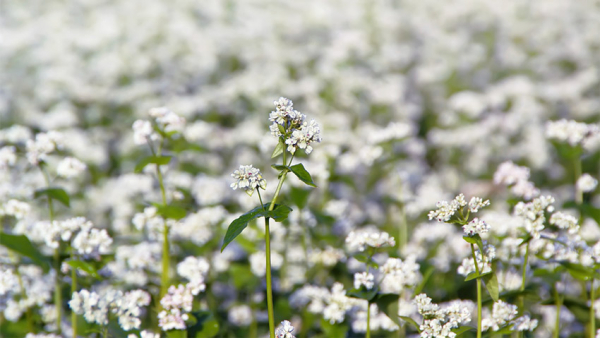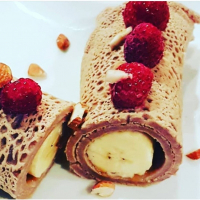Why should you include buckwheat, this ‘star’ ingredient in Pain des Fleurs Crispbread, in your diet? Here are six (very) good reasons that should persuade you.
Reason no. 1: Get your fill of good-quality protein!
Although it is not a cereal at all (it is technically a pseudocereal), buckwheat is often compared to wheat or rye. On the other hand, compared with the latter two, it has a higher protein content. Up to 15% of the dry weight of buckwheat can be protein. But, more importantly, it contains all amino acids, which makes buckwheat an excellent source of protein, particularly useful for athletes, vegetarians and vegans.
Reason no. 2: It is gluten-free!
In spite of the “wheat” portion of its name, buckwheat (famously used to make pancakes in Brittany) is not a member of the wheat family and contains no gluten. This makes it the ideal ingredient for persons sensitive or intolerant to gluten, and for anyone looking to reduce their gluten intake. Buckwheat is also widely popular for its nutty taste and the organoleptic qualities it provides in a whole host of recipes. It is also used as a flour in making buckwheat pancakes in Brittany, 'crozet savoyard’ pasta, ‘tourtou corrézien’ pancakes and even Japanese soba noodles, cake-making and more.
Reason no. 3: It promotes feelings of fullness
Buckwheat contains complex carbohydrates as well as water-soluble fibre such as pectin, which is excellent for achieving satiety. It has also been shown that people feel a greater degree of satiety after eating buckwheat pasta than after eating regular wheat pasta.
A breakfast of Pain des Fleurs Organic Buckwheat Crispbread can thus help you last until lunchtime without snacking.
Reason no. 4: It is a powerful antioxidant
In particular, it is rich in phenolic acids as well as flavonoids, whose anti-inflammatory and antioxidant properties promote cardiovascular health and could even prevent certain cancers.
In addition, it helps lower bad cholesterol and promotes good circulation.
Reason no. 5: It has a low glycemic load
Its glycemic index is between 30 and 35 (depending on the origin of the buckwheat), lower than that of wheat and other cereals. Its glycemic load (a more precise measurement than the glycemix index) puts it in the lower range of foodstuffs. These qualities are important for anyone looking to reduce their risk of diabetes and/or control their weight.
It is well-known that low- or moderate-GI foods can improve the treatment of diabetes, make it easier to lose body fat in the abdominal region, and improve athletic and intellectual performance.
Reason no. 6: It is rich in vitamins and minerals
Buckwheat contains over 230 mg of magnesium in only 100 g (the equivalent of one bowl).
Magnesium is an essential element for our body: it improves resistance to stress, reduces headaches and cramps by relaxing the muscles, and reduces blood pressure and the risk of cardiovascular diseases. However, In France, the SU.VI.MAX study showed that 23% of men are not getting 2/3 of their recommended intake of magnesium : adding buckwheat to your diet is an easy way of making up for this deficiency.
More recently, a European study has shown that the people who consumed the most magnesium reduced their risk of dying by 34%, for any reason (cardiovascular illnesses or cancer).
Buckwheat is also a valuable source of copper, phosphorus, zinc and calcium, as well as B vitamins, and, once again, more so than wheat. What is more, it is a prebiotic, which means that it stimulates the growth of good intestinal bacteria (probiotics), and thus promotes good digestion.
To conclude, here is a simple and effective recipe!
Buckwheat pancakes:
For 1 pancake, you will need:
- 50 g buckwheat flour
- 100 ml water
That's all!
In a pot, whisk the flour and water together. Cook the batter in a very hot pancake pan, for about 2 minutes on each side.
You can use the pancake as a ‘wrap’ and garnish with savoury ingredients, or roll it around a banana and coat with melted dark chocolate for a healthy, nutritious snack!







